| 1 | Gopher snake |
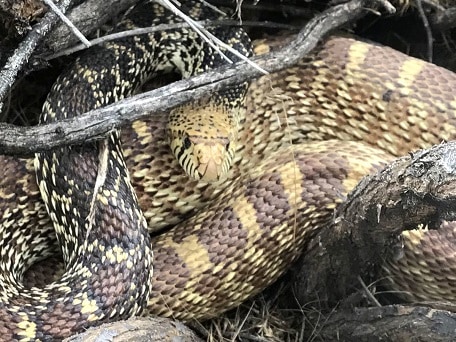
Record: 267.7cm.
Latin name: Pituophis canifer.
Various snakes are casually mentioned as the longest on US soil – coachwhips, east diamondback rattlesnakes. However, going by the official all-time record within each species, the official longest is the gopher snake. More specifically, the common subspecies known as the bull snake (Pituophis canifer sayi), which is widespread in the mid-west and even Canada.
Bull snakes are harmless constrictors, which lack venom, and attack by leaping forward and bashing people with their mouths closed. The average length is 1.2-1.8 metres, but the longest ever was discovered in June 1999, in Loma Alta, Val Verde County, Texas. After being kept and fed in captivity for two years, this bullsnake finally reached the supersized length of 267.7cm. This was the longest snake ever recorded in the USA, a record that still stands today.
Some mention an even longer record of 274.5cm, discovered in 1952. However, this was a skin measurement, and snake skins have a tendency to stretch out. Meanwhile, the Sonoran gopher snake is the second longest subspecies (Pituophis catenifer affinis), reaching a maximum of 233.7cm.
Note: this article excludes invasive species, like the 100,000 Burmese pythons estimated to be slithering around the Everglades.
| 2 | Eastern indigo snake |
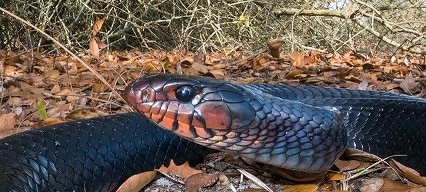
Record: 262.9cm.
Latin name: Drymarchon couperi.
The official second longest snake in the USA is the eastern indigo snake, which is found in most of Florida, and parts of Georgia and Alabama. This species is most heavily found in slash pine plantations, flatwoods, and longleaf pine forests, where it takes refuge in gopher tortoise burrows. This is a non-venomous species which has never caused a human fatality.
The average length is 152-213cm, which is already huge, but the longest ever recorded (though not necessarily the longest ever) measured 262.9cm. While eastern indigo snakes use constriction sometimes, they prefer to leap and grab their prey, grip them in a couple of loose coils, and forcefully shove them down their throats. Eastern indigo snakes are so large they can swallow eastern diamondback rattlesnakes.
While bullsnakes hold the top spot for US length, they’re also far more commonly encountered, occurring from northern Mexico to southern Canada. The eastern indigo snake is listed as vulnerable, and is estimated to number just over 10,000. They’re also naturally shier, appearing in secluded wooded areas and spending much of the day underground. It’s possible that the single largest snake in the US at this moment is actually an eastern indigo snake, but with no proof, we have to rely on official records, and therefore the bullsnake wins.
| 3 | Coachwhip |
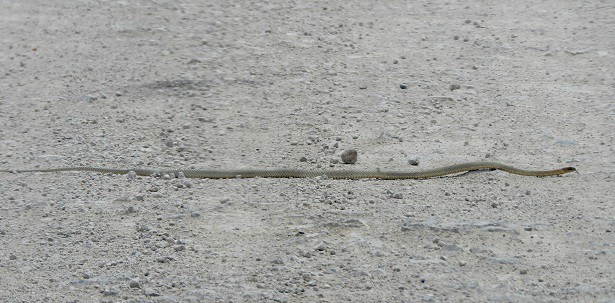
Record: 259.1cm.
Latin name: Masticophis flagellum.
Coachwhips are often proposed as a candidate for the US’s largest snake, and they’re only a few centimetres away from the supreme title. This species appears in the entire US south, from east to west, reaching as far north as Nebraska and Illinois.
127-183cm is average for an adult, and over 2 metres is nothing exceptional. The all time record was 259.1cm, which has stood for over 100 years. This was found in the eastern coachwhip (M. flagellum flagellum), the most common subspecies, which ranges from Florida to Texas and has a basic grey underlay with gold tinges. The coachwhip has six subspecies in total, including the Sonoran coachwhip, which is pink to camouflage against the local desert sands. This reached a record of 185.0cm, while the red coachwhip (also pink-tinged) reached a record of 172.8cm.
Coachwhips are also an incredibly fast snake, zooming over a dusty road like a bullet, and this is all the freakier when combined with their huge length. Their large size allows them to eat large prey, such as eastern cottontail rabbits, east diamondback rattlers, and red diamond rattlesnakes. Rather than bulky and brutish, this is a thinner snake, which charges its prey down using relentless speed, before grabbing and swallowing using nimble manoeuvres.
| 4 | Black ratsnake |
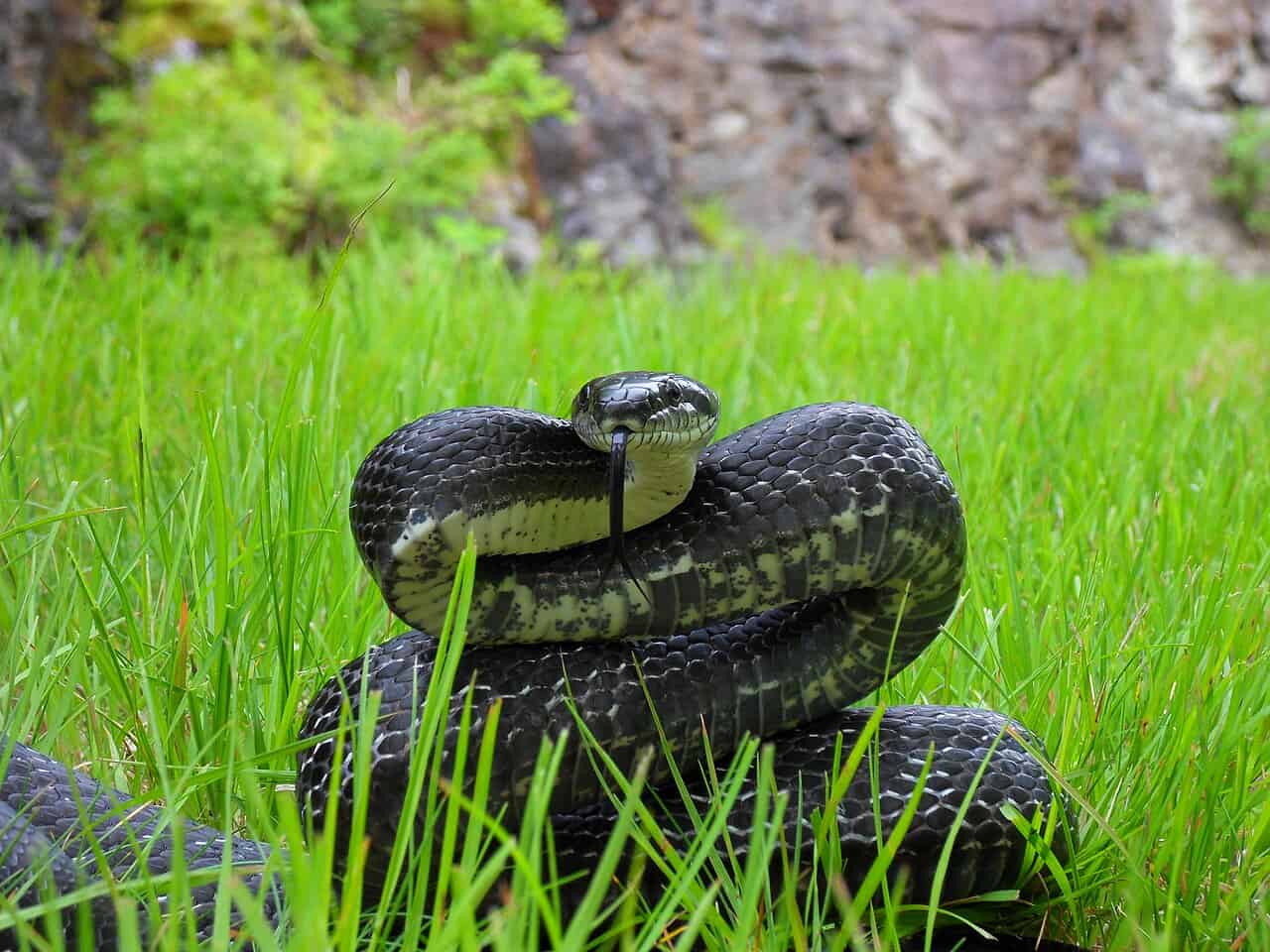
Record: 256.5cm.
Latin name: Pantherophis obsoletus.
A constrictor with excellent tree climbing skills, that commonly slithers into bird’s nests and swallows their eggs. Black ratsnakes average at 107-183cm, with a body width of 3.8cm at its widest point. They belong to the same Pantherophis family as corn snakes, and appear in various habitats, including farmland, grassy fields, rocky mountainsides, and marshland.
Black ratsnakes are common in the middle US, including in Arkansas, Missouri, Texas and Oklohoma. The diving line is the Mississippi river, as they’re only found to the west, while the grey ratsnake (Pantherophis spiloides) takes over to the east. While mostly black, an exception is their white chin, which continues along the belly.
Black ratsnakes lack venom, or especially sharp fangs. But as the image above shows, they often coil into tightly bunched coils, as though preparing to unleash a strike like a spring, deceiving enemies into thinking they’re venomous.
| 5 | Middle American indigo snake |
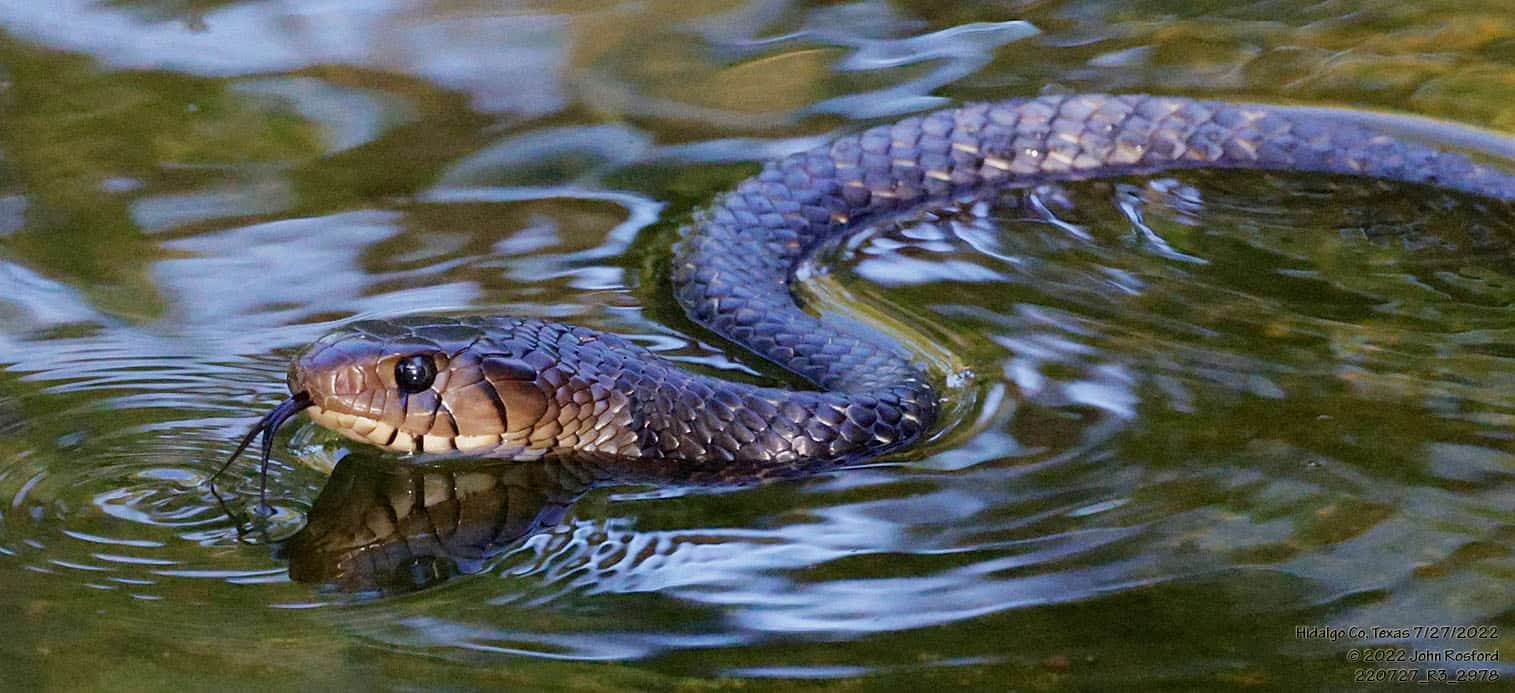
Record: 254.6cm.
Latin name: Drymarchon melanurus.
A separate species to the eastern indigo snake, which is found in the deep south of Texas instead, but is almost as long. Middle American indigo snakes have a similar lifestyle, searching actively for their prey, constricting them with a powerfully muscular body, and retreating to dark burrows to cool off.
Despite being less famous, the Middle American indigo snake is secretly far more common than its eastern cousin. It’s abundant in eastern Mexico, inhabits every central American country (Costa Rica, Panama), and only fizzles out in Ecuador and Peru. Five subspecies are now confirmed, but the only subspecies found in the US is the Texas indigo snake (Drymarchon melanurus erebennus), and this is what was once recorded at a road-blocking length of 254.6cm.
According to a 2016 study, the eastern and Middle American indigo snakes likely diverged 5.9 million years ago. This study also found that eastern indigo snakes are divided into two genetically distinct populations in Florida: Atlantic and Gulf. This was caused by ice age climate fluctuations, and the split likely occurred 2 million years ago.
| 6 | Eastern diamondback rattlesnake |
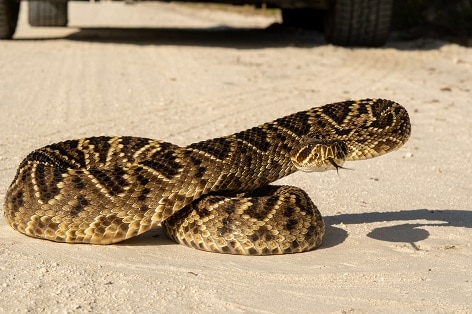
Record: 251.5cm.
Latin name: Crotalus adamanteus.
The heaviest snake in the USA (2-10 pounds) and almost the longest. East diamondbacks are the longest rattlesnake out of 50+ species worldwide, at an average of 150cm. The record was 251.5cm, easily enough to block a woodland trail, and probably a small road. Another huge individual was shot in 1944, and measured 244cm. Eastern diamondbacks have no subspecies, just a monolithic genetic pool across their southeast range. They live mainly in Florida, Georgia, Alabama and South Carolina, ending in extreme eastern Louisiana.
Thanks to their huge size, Crotalus adamanteus also has among the largest venom yields on Earth. One bite can produce 400-450mg of venom, compared to 3-5mg per bite for an eastern coral snake.
In 1954, a theory arose about a monstrous prehistoric rattlesnake called Crotalus giganteus. This was based off fossils found in Sabertooth Cave, Citrus County, Florida, specifically that of a large vertebrae measuring 17.7 x 13.3mm. After extrapolation, the researchers estimated that Crotalus giganteus reached a maximum length of 12 feet (365.8cm). It was a close relative of the eastern diamondback, but far bigger and more terrible. However, a 1977 analysis revealed that it was really just an east diamondback fossil all along, so it’s possible that they once reached even bigger sizes.
| 7 | Western diamondback rattlesnake |
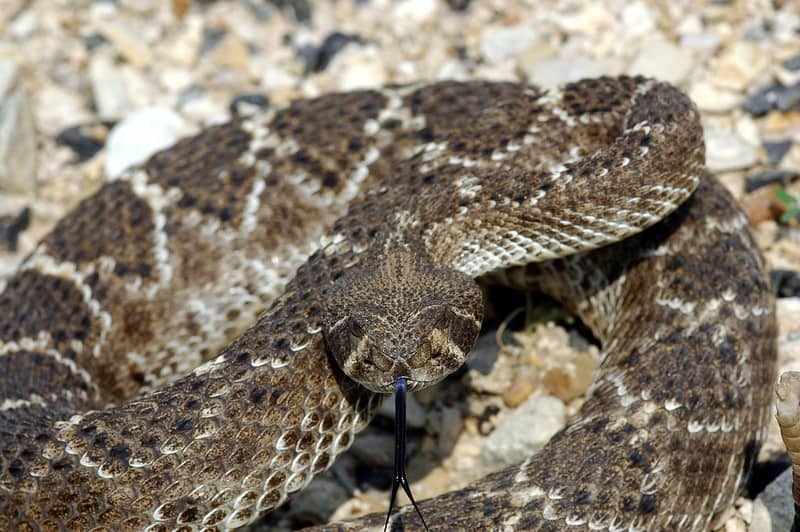
Record: 233.7cm.
Latin name: Crotalus atrox.
The venomous snake responsible for the most bites in the US annually. The western diamondback rattlesnake ranges from California to western Kansas, with no overlap with its eastern cousin. It’s unanimously agreed to be the shorter of the two, yet still the second longest rattlesnake worldwide, the third longest being the Mexican west coast rattlesnake (Crotalus basilicus).
This is also the largest rattlesnake in Arizona and Texas, with an average of 120-150cm. The longest ever was reported in 1956, measuring 237.7cm. This was found in Dallas County, Texas, and another brute measured 226cm, which was scooped up from Tamaulipas, northeast Mexico. According to snake lore, the longest western diamondback rattlesnakes come from southern Texas. Supposedly, the Lower Grande Rio Valley was once full of colossal ones, in the counties of Hidalgo and Starr. As a rule, male western diamondbacks are longer than females, and the same is true for eastern diamondbacks.
Once again, large size equals a tidalwave of venom. The average yield per bite is 250-350mg, while 800-850mg has been reported occasionally.
| 8 | Pine snake |
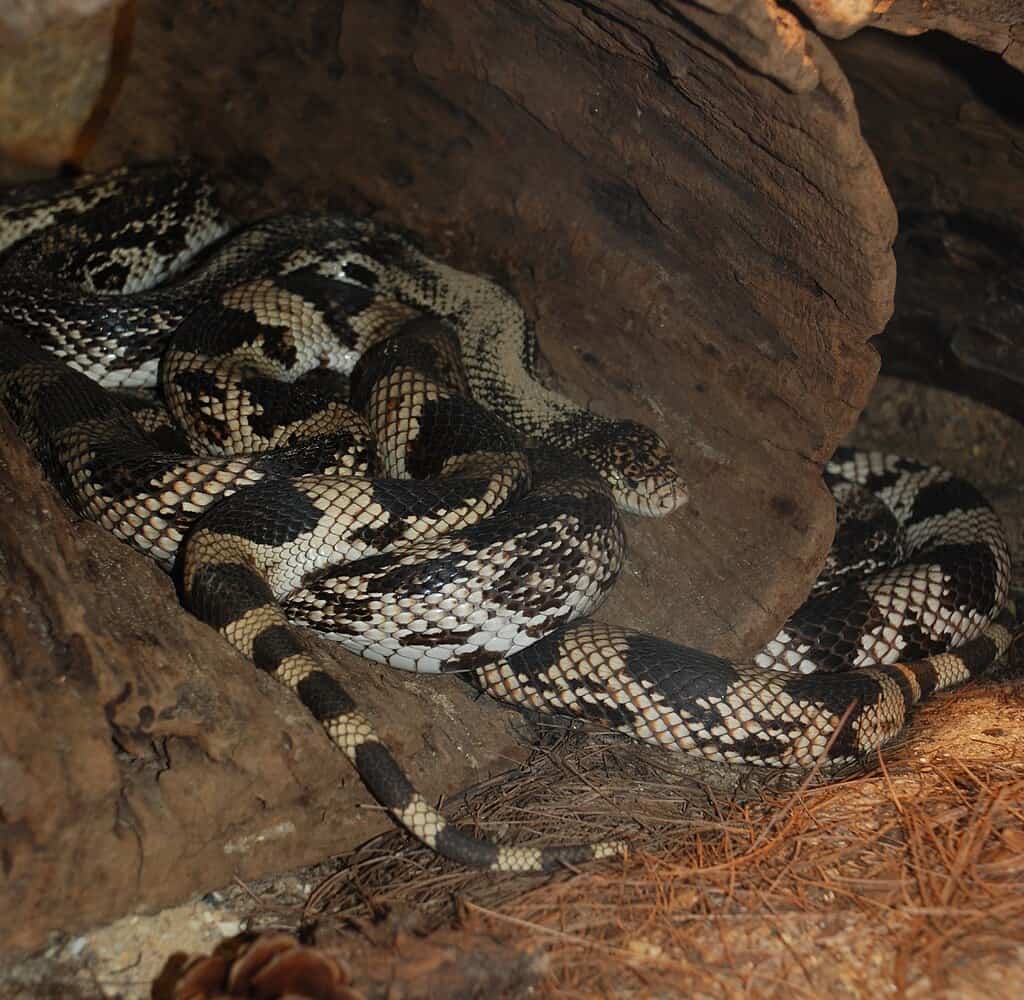
Record: 228.6cm.
Latin name: Pituophis melanoleucus.
A mammal-eating snake which is neither a constrictor nor venomous, more of a simple grabber. Like the eastern indigo, pine snakes are a lover of cool, dark burrows, which form a refuge in which they can plot future rodent quests. Depending on the weather, on overly cool or scorchingly sunny days, they may not emerge at all.
As of 2023, the confirmed record for this species is 228.6cm. Specifically, it was the Florida pine snake (Pituophis melanoleucus mugitus) subspecies that reached this record. This version is found in 4 states, mainly Florida, but also Georgia, eastern Alabama, and southern South Carolina. Pine snakes as a whole also have a northerly stronghold in New Jersey.
Being a large snake, pine snakes lay particularly large eggs, measuring 6.6cm by 4.5cm. These eggs are snowy white and tend to stick together. Hatchlings burst free at 33-45cm, and adults reach 150cm with ease. Despite their length, pine snakes aren’t immune from harm, even while in their cosy burrows. Confirmed predators include the American red fox and striped skunk.
| 9 | Common kingsnake |
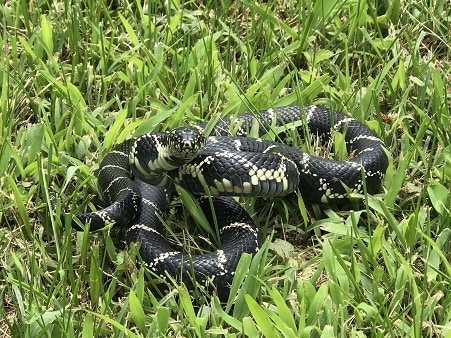
Record: 208.3cm.
Latin name: Lampropeltis getula.
Part of the large kingsnake family, and a separate species to such staples as the scarlet kingsnake (see this US kingsnake guide). The common kingsnake covers less territory than it used to, as many former subspecies were split off and made independent, such as the California kingsnake and desert kingsnake. However, it’s still extremely common, inhabiting the eastern coast from Florida to New York state.
The common kingsnake is a non-venomous constrictor with only moderately sized teeth, which largely preys on other snakes. Like any snake, or a Nile crocodile, their growth rate slows at age 3, but they keep growing for the rest of their lives. As long as there’s a plentiful supply of mice and rats, they can add additional centimetres each year, which is why a saltwater crocodile measuring 5.5 metres called Brutus (aged 80) was once a popular tourist feature in Australia.
Common kingsnakes average at 90-120cm, which isn’t enormous, but the largest of all time measured 208.3cm. They mainly inhabit open habitats such as grassland, abandoned farmland, and spacious woodlands.
| 10 | Mud snake |
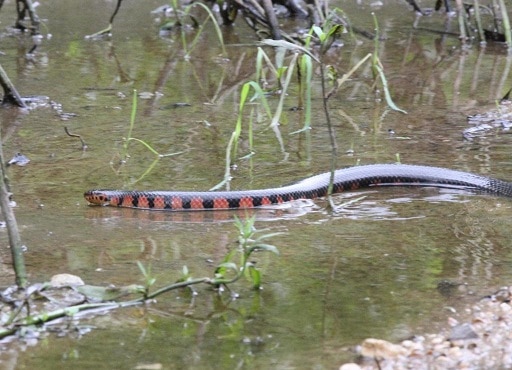
Record: 207.0cm.
Latin name: Farancia abacura.
A non-venomous constrictor which primarily feeds on amphibians, and has a large range in the US southeast, including Florida, Georgia, South Carolina and Alabama. The mud snake isn’t encountered commonly by ordinary people, and definitely not in towns or outside Walmart. Mud snakes live in swamps, including gloomy swamps frequented by alligators, as this video of one wrapped around an alligator’s snout like spaghetti proves.
This spaghetti incident was only possibly because the mud snake is a huge snake, which reaches an all time record of 207.0cm, with an average of 90-120cm. Fortunately, this is no nightmare snake, despite living in eerie habitats. Regardless of whether they’re 110cm or 190cm, mud snakes are calm and peaceful and can be picked up without biting painfully, or even thrashing wildly.
Mud snakes can lay over 100 eggs at once. Two converging factors cause this to happen: a large body, which literally allows more physical egg storage, and a watery habitat which is full of predators, causing high hatchling loss, followed by an arms race of higher eggs to compensate. Mud snakes are the longest primarily water-dwelling snake of the USA (excluding invasive species), beating cottonmouths and northern watersnakes.
